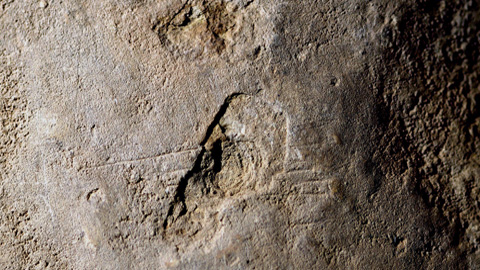Catalonia's oldest prehistoric engravings discovered

10/10/2017
The archaeologists, led by Professor in Prehistory Rafael Mora, identified strokes and signs which they are convinced form part of artistic representations from possibly the palaeolithic or epipalaeolithic chronology. The engravings are abstract and/or geometric, and contain highly deteriorated traces of a painting greatly damaged by exposition to the natural elements. This is a unique discovery in Catalonia, the oldest of its kind researchers assure.
Another important element of the research is that the representations are located between 0.5 and 1.5 metres above the cave's current ground level. That makes researchers think that there could be new discoveries further on, given that beneath them lies an important layer of sediments which must still be excavated.
Researchers identified the traces made on one of the cave's limestone walls which could be of certain antiquity during the 2016 dig campaign, and coincided with the Archaeology and Palaeontology Services of the Government of Catalonia in declaring the need for these elements to be analysed by other researchers in order to assess this possibility and evaluate the interest. The identification of the engravings included the collaboration of Rafael Martínez and Pere Guillem, experts in the Archaeology and Cave Paintings of the Valencian Institute of Conservation and Restoration of Cultural Heritage of the Generalitat of Valencia. Both are experts in the identification, description and interpretation of Levantine and schematic art cave paintings.
The location of the engravings is a subject which preoccupies researchers because they coincide with rock climbing routes, given that the area in which the paintings were discovered and its vicinities attract numerous rock climbers. The report drawn up by experts points out the wear and dents in the wall caused by this sport. For this reason, despite the BCIN declaration of the site and the protection it entails, researchers believe its preservation is in danger if no preventive actions are taken by the public administration.
They highlight the fact that the Cova Gran de Santa Linya is one of the few sites and perhaps the only one in Catalonia from this chronology, which conserves artistic representations on its walls. Now experts hope that the discovery will highlight the importance of these cultural representations, all too unknown in our country and which deserve to be protected by the administration in order to guarantee their conservation in the long run.
The relevance of the Cova Gran de Santa Linya (located in Les Avellanes-Santa Linya, La Noguera) can be seen in the continuous dig campaigns conducted in the past 15 years and in an important number of international scientific publications. During these years, researchers have generated a large volume of archaeological information essential to reconstructing the past 50,000 years of human presence in the northeastern part of the Iberian Peninsula, making Cova Gran a key site of the western Mediterranean.